Nikon D40X vs Panasonic L10
The Nikon D40X and the Panasonic Lumix DMC- L10 are two digital cameras that were revealed to the public, respectively, in March 2007 and August 2007. Both are DSLR (Digital Single Lens Reflex) cameras that are based on an APS-C (D40X) and a Four Thirds (L10) sensor. Both cameras offer a resolution of 10 megapixels.
Below is an overview of the main specs of the two cameras as a starting point for the comparison.

Check D40X offers at
ebay.com

Check L10 offers at
ebay.com
Going beyond this snapshot of core features and characteristics, what are the differences between the Nikon D40X and the Panasonic Lumix DMC- L10? Which one should you buy? Read on to find out how these two cameras compare with respect to their body size, their imaging sensors, their shooting features, their input-output connections, and their reception by expert reviewers.
Body comparison
The side-by-side display below illustrates the physical size and weight of the Nikon D40X and the Panasonic L10. The two cameras are presented according to their relative size. Three consecutive perspectives from the front, the top, and the back are available. All width, height and depth measures are rounded to the nearest millimeter.
The D40X can be obtained in two different colors (black, silver), while the L10 is only available in black.
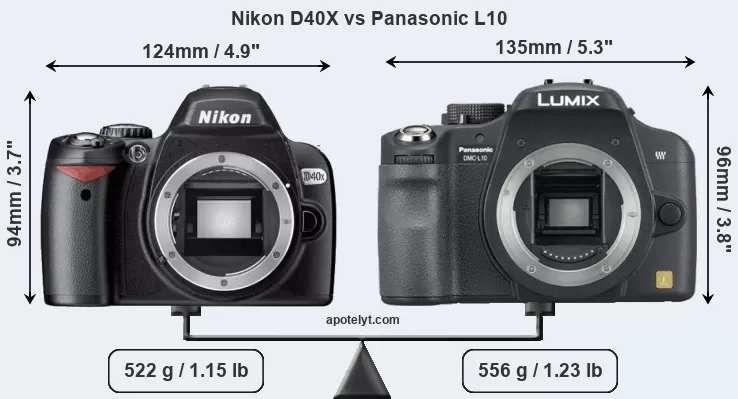
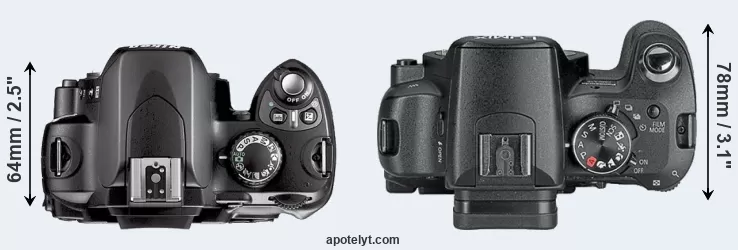
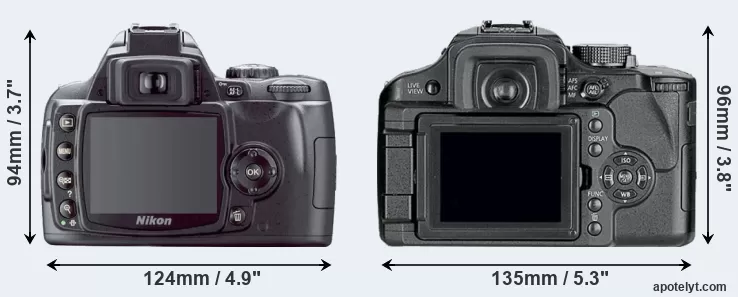
If the front view area (width x height) of the cameras is taken as an aggregate measure of their size, the Panasonic L10 is notably larger (11 percent) than the Nikon D40X. Moreover, the L10 is markedly heavier (7 percent) than the D40X. In this context, it is worth noting that neither the D40X nor the L10 are weather-sealed.
The above size and weight comparisons are to some extent incomplete since they do not consider the interchangeable lenses that both of these cameras require. A larger imaging sensor will tend to go along with bigger and heavier lenses, although exceptions exist. You can compare the optics available for the two cameras in the Nikon Lens Catalog (D40X) and the Four Thirds Lens Catalog (L10).
The adjacent table lists the principal physical characteristics of the two cameras alongside a wider set of alternatives. In case you want to display and compare another camera duo, you can use the CAM-parator app to select your camera combination among a large number of options.

| # | Camera Model |
Camera Width |
Camera Height |
Camera Depth |
Camera Weight |
Battery Life |
Weather Sealing |
Camera Launch |
Launch Price (USD) |
Street Price |
|
|---|---|---|---|---|---|---|---|---|---|---|---|
| 1. | Nikon D40X | 124 mm | 94 mm | 64 mm | 522 g | 520 | n | Mar 2007 | 729 | ebay.com | |
| 2. | Panasonic L10 | 135 mm | 96 mm | 78 mm | 556 g | 450 | n | Aug 2007 | 599 | ebay.com | |
| 3. | Nikon D3100 | 124 mm | 96 mm | 75 mm | 505 g | 550 | n | Aug 2010 | 599 | ebay.com | |
| 4. | Nikon D3000 | 126 mm | 97 mm | 64 mm | 536 g | 500 | n | Jul 2009 | 599 | ebay.com | |
| 5. | Nikon D5000 | 127 mm | 104 mm | 80 mm | 590 g | 510 | n | Apr 2009 | 749 | ebay.com | |
| 6. | Nikon D60 | 126 mm | 94 mm | 64 mm | 522 g | 500 | n | Jan 2008 | 629 | ebay.com | |
| 7. | Nikon D90 | 132 mm | 103 mm | 77 mm | 703 g | 850 | n | Aug 2008 | 1,299 | ebay.com | |
| 8. | Nikon D40 | 124 mm | 94 mm | 64 mm | 522 g | 470 | n | Nov 2006 | 499 | ebay.com | |
| 9. | Nikon D80 | 132 mm | 103 mm | 77 mm | 668 g | 600 | n | Aug 2006 | 999 | ebay.com | |
| 10. | Nikon D50 | 133 mm | 102 mm | 76 mm | 620 g | 400 | n | Apr 2005 | 749 | ebay.com | |
| 11. | Olympus E-420 | 130 mm | 91 mm | 53 mm | 440 g | 500 | n | Mar 2008 | 599 | ebay.com | |
| 12. | Olympus E-520 | 136 mm | 92 mm | 68 mm | 535 g | 750 | n | May 2008 | 699 | ebay.com | |
| 13. | Olympus E-410 | 130 mm | 91 mm | 53 mm | 435 g | 500 | n | Mar 2007 | 699 | ebay.com | |
| 14. | Panasonic G10 | 124 mm | 84 mm | 74 mm | 388 g | 380 | n | Mar 2010 | 499 | ebay.com | |
| 15. | Panasonic L1 | 146 mm | 87 mm | 64 mm | 606 g | 750 | n | Feb 2006 | 999 | ebay.com | |
| Note: Measurements and pricing do not include easily detachable parts, such as add-on or interchangeable lenses or optional viewfinders. | |||||||||||
Any camera decision will naturally be influenced heavily by the price. The listed launch prices provide an indication of the market segment that the manufacturer of the cameras have been targeting. The L10 was launched at a somewhat lower price (by 18 percent) than the D40X, which makes it more attractive for photographers on a tight budget. Usually, retail prices stay at first close to the launch price, but after several months, discounts become available. Later in the product cycle and, in particular, when the replacement model is about to appear, further discounting and stock clearance sales often push the camera price considerably down. Then, after the new model is out, very good deals can frequently be found on the pre-owned market.
Sensor comparison
The size of the imaging sensor is a crucial determinant of image quality. A large sensor will tend to have larger individual pixels that provide better low-light sensitivity, wider dynamic range, and richer color-depth than smaller pixel-units in a sensor of the same technological generation. Moreover, a large sensor camera will give the photographer more control over depth-of-field in the image and, thus, the ability to better isolate a subject from the background. On the downside, larger sensors tend to be more expensive and lead to bigger and heavier cameras and lenses.
Of the two cameras under consideration, the Nikon D40X features an APS-C sensor and the Panasonic L10 a Four Thirds sensor. The sensor area in the L10 is 40 percent smaller. As a result of these sensor size differences, the cameras have a format factor of, respectively, 1.5 and 2.0. The sensor in the D40X has a native 3:2 aspect ratio, while the one in the L10 offers a 4:3 aspect.
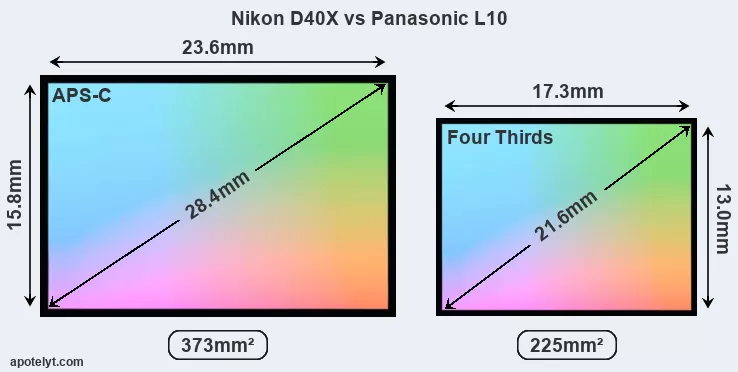
Even though the D40X has a larger sensor, both cameras offer the same resolution of 10 megapixels. This implies that the D40X has a lower pixel density and larger individual pixels (with a pixel pitch of 6.11μm versus 4.74μm for the L10), which gives it a potential advantage in terms of light gathering capacity. It should, however, be noted that the L10 is a somewhat more recent model (by 5 months) than the D40X, and its sensor might have benefitted from technological advances during this time that at least partly compensate for the smaller pixel size.
The Nikon D40X has a native sensitivity range from ISO 100 to ISO 1600, which can be extended to ISO 100-3200. The corresponding ISO settings for the Panasonic Lumix DMC- L10 are ISO 100 to ISO 1600 (no boost).
In terms of underlying technology, the D40X is build around a CCD sensor, while the L10 uses a CMOS imager. Both cameras use a Bayer filter for capturing RGB colors on a square grid of photosensors. This arrangement is found in most digital cameras.
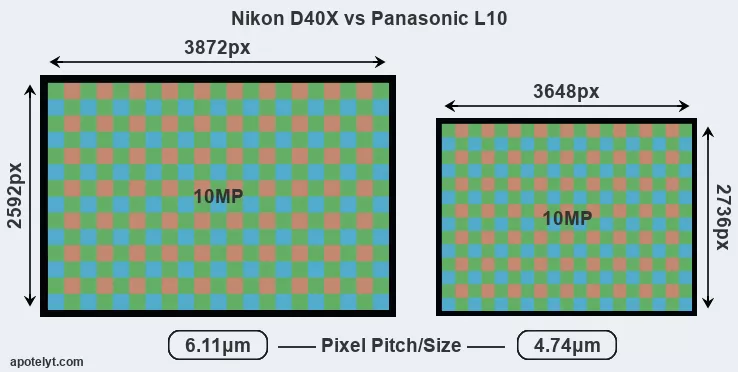
Since 2007, DXO Mark has published sensor performance measurements that have been derived using a consistent methodology. This service determines an overall sensor rating, as well as sub-scores for low-light sensitivity ("DXO Sports"), dynamic range ("DXO Landscape"), and color depth ("DXO Portrait"). Of the two cameras under review, the D40X has a notably higher overall DXO score than the L10 (overall score 8 points higher), which gives it an advantage in terms of imaging quality. This advantage is based on 1.1 bits higher color depth, 0.6 EV in additional dynamic range, and 0.3 stops in additional low light sensitivity. The following table provides an overview of the physical sensor characteristics, as well as the sensor quality measurements for a selection of comparators.

| # | Camera Model |
Sensor Class |
Resolution (MP) |
Horiz. Pixels |
Vert. Pixels |
Video Format |
DXO Portrait |
DXO Landscape |
DXO Sports |
DXO Overall |
|
|---|---|---|---|---|---|---|---|---|---|---|---|
| 1. | Nikon D40X | APS-C | 10.0 | 3872 | 2592 | none | 22.4 | 11.4 | 516 | 63 | |
| 2. | Panasonic L10 | Four Thirds | 10.0 | 3648 | 2736 | none | 21.3 | 10.8 | 429 | 55 | |
| 3. | Nikon D3100 | APS-C | 14.2 | 4608 | 3072 | 1080/24p | 22.5 | 11.3 | 919 | 67 | |
| 4. | Nikon D3000 | APS-C | 10.0 | 3872 | 2592 | none | 22.3 | 11.1 | 563 | 62 | |
| 5. | Nikon D5000 | APS-C | 12.2 | 4288 | 2848 | 720/24p | 22.7 | 12.5 | 868 | 72 | |
| 6. | Nikon D60 | APS-C | 10.0 | 3872 | 2592 | none | 22.5 | 11.4 | 562 | 65 | |
| 7. | Nikon D90 | APS-C | 12.2 | 4288 | 2848 | 720/24p | 22.7 | 12.5 | 977 | 73 | |
| 8. | Nikon D40 | APS-C | 6.0 | 3008 | 2000 | none | 21.0 | 11.0 | 561 | 56 | |
| 9. | Nikon D80 | APS-C | 10.0 | 3872 | 2592 | none | 22.1 | 11.2 | 524 | 61 | |
| 10. | Nikon D50 | APS-C | 6.0 | 3008 | 2000 | none | 20.9 | 10.8 | 560 | 55 | |
| 11. | Olympus E-420 | Four Thirds | 10.0 | 3648 | 2736 | none | 21.5 | 10.4 | 527 | 56 | |
| 12. | Olympus E-520 | Four Thirds | 10.0 | 3648 | 2736 | none | 21.4 | 10.4 | 548 | 55 | |
| 13. | Olympus E-410 | Four Thirds | 10.0 | 3648 | 2736 | none | 21.1 | 10.0 | 494 | 51 | |
| 14. | Panasonic G10 | Four Thirds | 12.0 | 4000 | 3000 | 720/30p | 21.2 | 10.1 | 411 | 52 | |
| 15. | Panasonic L1 | Four Thirds | 7.4 | 3136 | 2352 | none | 20.8 | 10.4 | 80 | 52 | |
| Note: DXO values in italics represent estimates based on sensor size and age. | |||||||||||
Feature comparison
Apart from body and sensor, cameras can and do differ across a variety of features. The D40X and the L10 are similar in the sense that both have an optical viewfinder. The latter is useful for getting a clear image for framing even in brightly lit environments. The viewfinders of both cameras offer the same field of view (95%), but the viewfinder of the D40X has a higher magnification than the one of the L10 (0.53x vs 0.46x), so that the size of the image transmitted appears closer to the size seen with the naked human eye. The table below summarizes some of the other core capabilities of the Nikon D40X and Panasonic L10 in connection with corresponding information for a sample of similar cameras.

| # | Camera Model |
Viewfinder (Type or 000 dots) |
Control Panel (yes/no) |
LCD Specifications (inch/000 dots) |
LCD Attach- ment |
Touch Screen (yes/no) |
Max Shutter Speed * |
Max Shutter Flaps * |
Built-in Flash (yes/no) |
Built-in Image Stab |
|
|---|---|---|---|---|---|---|---|---|---|---|---|
| 1. | Nikon D40X | optical | n | 2.5 / 230 | fixed | n | 1/4000s | 3.0/s | Y | n | |
| 2. | Panasonic L10 | optical | n | 2.5 / 207 | swivel | n | 1/4000s | 3.0/s | Y | n | |
| 3. | Nikon D3100 | optical | n | 3.0 / 230 | fixed | n | 1/4000s | 3.0/s | Y | n | |
| 4. | Nikon D3000 | optical | n | 3.0 / 230 | fixed | n | 1/4000s | 3.0/s | Y | n | |
| 5. | Nikon D5000 | optical | n | 2.7 / 230 | full-flex | n | 1/4000s | 4.0/s | Y | n | |
| 6. | Nikon D60 | optical | n | 2.5 / 230 | fixed | n | 1/4000s | 3.0/s | Y | n | |
| 7. | Nikon D90 | optical | Y | 3.0 / 920 | fixed | n | 1/4000s | 4.5/s | Y | n | |
| 8. | Nikon D40 | optical | n | 2.5 / 230 | fixed | n | 1/4000s | 2.5/s | Y | n | |
| 9. | Nikon D80 | optical | n | 2.5 / 230 | fixed | n | 1/4000s | 3.0/s | Y | n | |
| 10. | Nikon D50 | optical | n | 2.0 / 130 | fixed | n | 1/4000s | 2.5/s | Y | n | |
| 11. | Olympus E-420 | optical | n | 2.7 / 215 | fixed | n | 1/4000s | 3.5/s | Y | n | |
| 12. | Olympus E-520 | optical | n | 2.7 / 215 | fixed | n | 1/4000s | 3.5/s | Y | Y | |
| 13. | Olympus E-410 | optical | n | 2.5 / 215 | fixed | n | 1/4000s | 3.0/s | Y | n | |
| 14. | Panasonic G10 | 202 | n | 3.0 / 460 | fixed | n | 1/4000s | 2.6/s | Y | n | |
| 15. | Panasonic L1 | optical | n | 2.5 / 207 | fixed | n | 1/4000s | 3.0/s | Y | n | |
| Note: *) Information refers to the mechanical shutter, unless the camera only has an electronic one. | |||||||||||
Concerning the storage of imaging data, both the D40X and the L10 write their files to SDHC cards.
Connectivity comparison
For some imaging applications, the extent to which a camera can communicate with its environment can be an important aspect in the camera decision process. The table below provides an overview of the connectivity of the Nikon D40X and Panasonic Lumix DMC- L10 and, in particular, the interfaces the cameras (and selected comparators) provide for accessory control and data transfer.

| # | Camera Model |
Hotshoe Port |
Internal Mic / Speaker |
Microphone Port |
Headphone Port |
HDMI Port |
USB Port |
WiFi Support |
NFC Support |
Bluetooth Support |
|
|---|---|---|---|---|---|---|---|---|---|---|---|
| 1. | Nikon D40X | Y | - / - | - | - | - | 2.0 | - | - | - | |
| 2. | Panasonic L10 | Y | - / - | - | - | - | 2.0 | - | - | - | |
| 3. | Nikon D3100 | Y | mono / mono | - | - | mini | 2.0 | - | - | - | |
| 4. | Nikon D3000 | Y | - / - | - | - | - | 2.0 | - | - | - | |
| 5. | Nikon D5000 | Y | mono / mono | - | - | mini | 2.0 | - | - | - | |
| 6. | Nikon D60 | Y | - / - | - | - | - | 2.0 | - | - | - | |
| 7. | Nikon D90 | Y | mono / mono | - | - | mini | 2.0 | - | - | - | |
| 8. | Nikon D40 | Y | - / - | - | - | - | 2.0 | - | - | - | |
| 9. | Nikon D80 | Y | - / - | - | - | - | 2.0 | - | - | - | |
| 10. | Nikon D50 | Y | - / - | - | - | - | 2.0 | - | - | - | |
| 11. | Olympus E-420 | Y | - / - | - | - | - | 2.0 | - | - | - | |
| 12. | Olympus E-520 | Y | - / - | - | - | - | 2.0 | - | - | - | |
| 13. | Olympus E-410 | Y | - / - | - | - | - | 2.0 | - | - | - | |
| 14. | Panasonic G10 | Y | mono / - | - | - | mini | 2.0 | - | - | - | |
| 15. | Panasonic L1 | Y | - / - | - | - | - | 2.0 | - | - | - |
Both the D40X and the L10 have been discontinued, but can regularly be found used on ebay. The D40X was replaced by the Nikon D60 , while the L10 does not have a direct successor. Further information on the features and operation of the D40X and L10 can be found, respectively, in the Nikon D40X Manual (free pdf) or the online Panasonic L10 Manual.
Review summary
So what conclusions can be drawn? Is the Nikon D40X better than the Panasonic L10 or vice versa? A synthesis of the relative strong points of each of the models is listed below.

Reasons to prefer the Nikon D40X:
- Better image quality: Scores markedly higher (8 points) in the DXO overall assessment.
- Richer colors: Generates images with noticeably better colors (1.1 bits more color depth).
- More dynamic range: Captures a larger spectrum of light and dark details (0.6 EV of extra DR).
- Larger viewfinder image: Features a viewfinder with a higher magnification (0.53x vs 0.46x).
- More detailed LCD: Has a higher resolution rear screen (230k vs 207k dots).
- Longer lasting: Can take more shots (520 versus 450) on a single battery charge.
- More heavily discounted: Has been on the market for longer (launched in March 2007).

Advantages of the Panasonic Lumix DMC- L10:
- More flexible LCD: Has a swivel screen for odd-angle shots in portrait or landscape orientation.
- More selfie-friendly: Has an articulated screen that can be turned to be front-facing.
- More affordable: Was released into a lower priced segment (18 percent cheaper at launch).
- More modern: Was introduced somewhat (5 months) more recently.
If the count of relative strengths (bullet points above) is taken as a measure, the D40X emerges as the winner of the contest (7 : 4 points). However, the relative importance of the various individual camera aspects will vary according to personal preferences and needs, so that you might like to apply corresponding weights to the particular features before making a decision on a new camera. A professional sports photographer will view the differences between cameras in a way that diverges from the perspective of a street photog, and a person interested in family portraits has distinct needs from a landscape shooter. Hence, the decision which camera is best and worth buying is often a very personal one.
How about other alternatives? Do the specifications of the Nikon D40X and the Panasonic L10 place the cameras among the top in their class? Find out in the latest Best DSLR Camera listing whether the two cameras rank among the cream of the crop.
In any case, while the specs-based evaluation of cameras can be instructive in revealing their potential as photographic tools, it says little about, for example, the shooting experience and imaging performance of the D40X and the L10 in practical situations. User reviews, such as those found at amazon, can sometimes inform about these issues, but such feedback is often incomplete, inconsistent, and biased.
Expert reviews
This is why hands-on reviews by experts are important. The following table reports the overall ratings of the cameras as published by some of the major camera review sites (amateurphotographer [AP], cameralabs [CL], digitalcameraworld [DCW], dpreview [DPR], ephotozine [EPZ], photographyblog [PB]). As can be seen, the professional reviewers agree in many cases on the quality of different cameras, but sometimes their assessments diverge, reinforcing the earlier point that a camera decision is often a very personal choice.

| # | Camera Model |
AP score |
CL score |
DCW score |
DPR score |
EPZ score |
PB score |
Camera Launch |
Launch Price (USD) |
Street Price |
|
|---|---|---|---|---|---|---|---|---|---|---|---|
| 1. | Nikon D40X | .. | 79/100 | .. | + + | 4/5 | 4/5 | Mar 2007 | 729 | ebay.com | |
| 2. | Panasonic L10 | .. | 85/100 | .. | + | 3.5/5 | 4/5 | Aug 2007 | 599 | ebay.com | |
| 3. | Nikon D3100 | 5/5 | + + | .. | 72/100 | 4.5/5 | 4.5/5 | Aug 2010 | 599 | ebay.com | |
| 4. | Nikon D3000 | .. | + | .. | 72/100 | 4/5 | 4.5/5 | Jul 2009 | 599 | ebay.com | |
| 5. | Nikon D5000 | .. | + + | .. | 75/100 | 4/5 | 4.5/5 | Apr 2009 | 749 | ebay.com | |
| 6. | Nikon D60 | .. | 80/100 | .. | + + | 4/5 | 4.5/5 | Jan 2008 | 629 | ebay.com | |
| 7. | Nikon D90 | .. | + + | .. | + + | 4/5 | 4.5/5 | Aug 2008 | 1,299 | ebay.com | |
| 8. | Nikon D40 | .. | 81/100 | .. | + + | o | 4.5/5 | Nov 2006 | 499 | ebay.com | |
| 9. | Nikon D80 | .. | + | .. | + + | o | 4.5/5 | Aug 2006 | 999 | ebay.com | |
| 10. | Nikon D50 | .. | 78/100 | .. | + + | 4/5 | 4.5/5 | Apr 2005 | 749 | ebay.com | |
| 11. | Olympus E-420 | .. | 85/100 | .. | + + | 4/5 | 4.5/5 | Mar 2008 | 599 | ebay.com | |
| 12. | Olympus E-520 | .. | 87/100 | .. | + + | 4.5/5 | 4.5/5 | May 2008 | 699 | ebay.com | |
| 13. | Olympus E-410 | .. | 86/100 | .. | + + | 4/5 | 4.5/5 | Mar 2007 | 699 | ebay.com | |
| 14. | Panasonic G10 | 3/5 | .. | .. | 70/100 | 4/5 | 4/5 | Mar 2010 | 499 | ebay.com | |
| 15. | Panasonic L1 | .. | 85/100 | .. | + | .. | 3.5/5 | Feb 2006 | 999 | ebay.com | |
| Note: (+ +) highly recommended; (+) recommended; (o) reviewed; (..) not available. | |||||||||||
The review scores listed above should be treated with care, though. The assessments were made in relation to similar cameras of the same technological generation. A score, therefore, has to be seen in close connection to the price and market introduction time of the camera, and rating-comparisons among cameras that span long time periods or concern very differently equipped models make little sense. Also, kindly note that some of the listed sites have over time developped their review approaches and their reporting style.

Check D40X offers at
ebay.com

Check L10 offers at
ebay.com
Other camera comparisons
Did this review help to inform your camera decision process? In case you are interested in seeing how other cameras pair up, just make a corresponding selection in the search boxes below. There is also a set of direct links to comparison reviews that other users of the CAM-parator app explored.
- Canon G16 vs Nikon D40X
- Canon G7 X Mark II vs Nikon D40X
- Canon Rebel vs Panasonic L10
- Canon SX720 vs Nikon D40X
- Kodak S-1 vs Nikon D40X
- Nikon D40X vs Panasonic G95
- Nikon D40X vs Panasonic TZ100
- Nikon D60 vs Panasonic L10
- Panasonic FZ1000 vs Panasonic L10
- Panasonic G10 vs Panasonic L10
- Panasonic L10 vs Panasonic ZS200
- Panasonic L10 vs Sony A900
Specifications: Nikon D40X vs Panasonic L10
Below is a side-by-side comparison of the specs of the two cameras to facilitate a quick review of their differences and common features.
| Camera Model | Nikon D40X | Panasonic L10 |
|---|---|---|
| Camera Type | Digital single lens reflex | Digital single lens reflex |
| Camera Lens | Nikon F mount lenses | Four Thirds lenses |
| Launch Date | March 2007 | August 2007 |
| Launch Price | USD 729 | USD 599 |
| Sensor Specs | Nikon D40X | Panasonic L10 |
| Sensor Technology | CCD | CMOS |
| Sensor Format | APS-C Sensor | Four Thirds Sensor |
| Sensor Size | 23.6 x 15.8 mm | 17.3 x 13.0 mm |
| Sensor Area | 372.88 mm2 | 224.9 mm2 |
| Sensor Diagonal | 28.4 mm | 21.6 mm |
| Crop Factor | 1.5x | 2.0x |
| Sensor Resolution | 10 Megapixels | 10 Megapixels |
| Image Resolution | 3872 x 2592 pixels | 3648 x 2736 pixels |
| Pixel Pitch | 6.11 μm | 4.74 μm |
| Pixel Density | 2.69 MP/cm2 | 4.44 MP/cm2 |
| Moiré control | Anti-Alias filter | Anti-Alias filter |
| Movie Capability | no Video | no Video |
| ISO Setting | 100 - 1,600 ISO | 100 - 1,600 ISO |
| ISO Boost | 100 - 3,200 ISO | no Enhancement |
| Image Processor | EXPEED | Venus |
| DXO Sensor Quality (score) | 63 | 55 |
| DXO Color Depth (bits) | 22.4 | 21.3 |
| DXO Dynamic Range (EV) | 11.4 | 10.8 |
| DXO Low Light (ISO) | 516 | 429 |
| Screen Specs | Nikon D40X | Panasonic L10 |
| Viewfinder Type | Optical viewfinder | Optical viewfinder |
| Viewfinder Field of View | 95% | 95% |
| Viewfinder Magnification | 0.53x | 0.46x |
| LCD Framing | Live View | |
| Rear LCD Size | 2.5inch | 2.5inch |
| LCD Resolution | 230k dots | 207k dots |
| LCD Attachment | Fixed screen | Swivel screen |
| Shooting Specs | Nikon D40X | Panasonic L10 |
| Focus System | Phase-detect AF | Phase-detect AF |
| Continuous Shooting | 3 shutter flaps/s | 3 shutter flaps/s |
| Fill Flash | Built-in Flash | Built-in Flash |
| Storage Medium | SDHC cards | SDHC cards |
| Single or Dual Card Slots | Single card slot | Single card slot |
| UHS card support | no | no |
| Connectivity Specs | Nikon D40X | Panasonic L10 |
| External Flash | Hotshoe | Hotshoe |
| USB Connector | USB 2.0 | USB 2.0 |
| HDMI Port | no HDMI | no HDMI |
| Wifi Support | no Wifi | no Wifi |
| Body Specs | Nikon D40X | Panasonic L10 |
| Battery Type | Nikon EN-EL9 | Panasonic DMW-BLA13 |
| Battery Life (CIPA) | 520 shots per charge | 450 shots per charge |
| Body Dimensions |
124 x 94 x 64 mm (4.9 x 3.7 x 2.5 in) |
135 x 96 x 78 mm (5.3 x 3.8 x 3.1 in) |
| Camera Weight | 522 g (18.4 oz) | 556 g (19.6 oz) |

Check D40X offers at
ebay.com

Check L10 offers at
ebay.com
Did you notice an error on this page? If so, please get in touch, so that we can correct the information.

